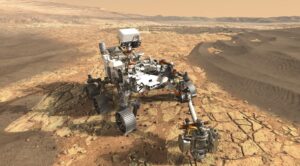NASA to perform independent review of Mars sample return plans
By Jeff Foust

WASHINGTON — NASA will carry out an independent review of its overall efforts to return samples from Mars, seeking to find any potential issues with the campaign while still in its earliest stages of development.
NASA announced Aug. 14 it will establish a Mars Sample Return Independent Review Board to examine the agency’s current plans to return samples from Mars, which started with the Mars 2020 mission launched July 30. The board will be chaired by David Thompson, the former president of Orbital ATK who retired shortly after his company was acquired by Northrop Grumman in 2018.
“This review will give us the chance to focus on overall mission success and to consider potential improvements that can be made early in the program to help ensure that outcome,” Thompson said in a NASA statement.
Jeff Gramling, Mars Sample Return program director at NASA Headquarters, said at an Aug. 17 meeting of NASA’s Planetary Science Advisory Committee that Thomas Zurbuchen, NASA associate administrator for science, requested the independent review based on the experience with similar reviews of other programs, including what is now known as the Nancy Grace Roman Space Telescope. That mission, previously known as the Wide-Field Infrared Survey Telescope, went through a similar review in 2017 when it was facing cost overruns.
“The goals of the review are to make sure we’re on a firm foundation technically going forward, to review the concepts that have been developed to date, and also to look at the cost and schedule that we’re proposing and to make sure that they agree that we’ve got the right resources we need to do this job,” Gramling said.
The independent review is scheduled to last eight weeks, with preliminary results briefed to NASA after six weeks. Gramling said that, in addition to the independent review board, The Aerospace Corporation is performing a cost and schedule review for Mars Sample Return. Both reviews will support a mission concept review for the program, which was moved from early August to mid-October so it can incorporate the results of the independent reviews.
In his presentation to the committee, Gramling didn’t suggest any major changes were pending to the Mars Sample Return campaign. The Perseverance rover that Mars 2020 will deliver to the surface of Mars next February will cache samples of Martian rocks. A lander mission, scheduled for launch in 2026, will collect those samples, load them into a canister and launch it into Martian orbit. An Earth Return Orbiter, also launched in 2026, will grab the canister and return it to Earth, landing in the Utah desert in 2031.
The overall Mars Sample Return effort will likely cost more than $7 billion between NASA and the European Space Agency, which is partnering on the campaign. Mars 2020 cost $2.4 billion to build, plus $300 million for its first Martian year of operations. At a July 28 press conference, David Parker, director of human and robotic exploration at ESA, estimated that the Earth Return Orbiter that ESA will develop, along with a small “fetch” rover for the NASA-led lander, will cost 1.5 billion euros ($1.8 billion) over the next decade. Zurbuchen, at the same briefing, offered a “first guess” for the cost of NASA’s role in those future missions at $2.5–3 billion.
That could make Mars Sample Return the most expensive set of Mars missions to date. NASA’s twin Viking missions, which each had an orbiter and lander, cost an estimated $7.1 billion in 2020 dollars, according to an analysis by The Planetary Society.
That’s added to the pressure to better understand the true cost of the campaign of missions as soon as possible. Gramling referred to lessons learned from the development of the Curiosity rover mission, which “suggested we really get our arms around cost and schedule estimates early.”
“The primary objectives are to make sure we’re on a good footing going forward and that we have the resources we need to execute the mission and be successful,” he said.
August 18, 2020 at 02:50PM
via SpaceNews read more...

Post a Comment